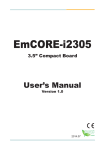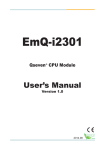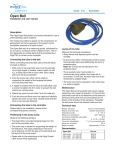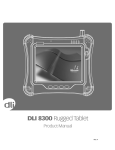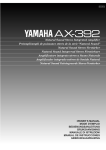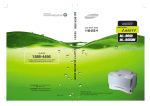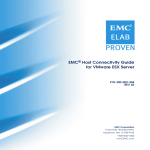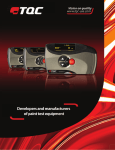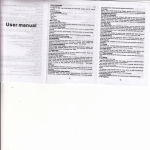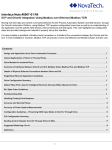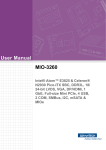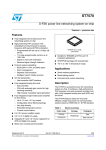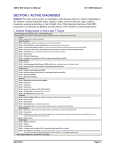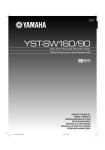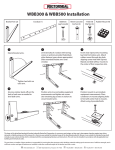Download EmNANO-i2300
Transcript
EmNANO-i2300 COM Express® Mini Type 10 CPU Module User’s Manual Version 1.0 2014.08 1 This page is intentionally left blank. -2- Revision History Version Release Time 1.0 August, 2014 -i- Description Initial release This page is intentionally left blank. - ii - Contents Table of Contents Revision History..................................................................................i Table of Contents..............................................................................iii Preface................................................................................................v Copyright Notice...................................................................................... v Declaration of Conformity........................................................................ v CE..................................................................................................... v FCC Class A.................................................................................... vi RoHS............................................................................................... vi SVHC / REACH...............................................................................vii Warning...................................................................................................vii Replacing Lithium Battery.......................................................................vii Technical Support...................................................................................vii Warranty................................................................................................viii Chapter 1 - Introduction.....................................................................1 1.1. The Product...................................................................................... 2 1.2. About this Manual............................................................................. 2 1.3. Specifications.................................................................................... 3 1.4. Inside the Package........................................................................... 4 1.5. Ordering Information......................................................................... 4 Chapter 2 - Getting Started................................................................5 2.1. The Ultra-small COM Express® Mini Module.................................... 6 2.2. Block Diagram................................................................................... 7 2.3 Board Dimensions.............................................................................. 8 2.4 COM Express® Mini Type 10 AB Connector...................................... 9 2.5 Connectors Quick Reference........................................................... 11 2.6. Driver Installation Notes.................................................................. 11 Chapter 3 - BIOS...............................................................................13 3.1. Main................................................................................................ 15 3.2. Advanced........................................................................................ 16 3.2.1. Boot Configuration................................................................ 18 3.2.2. PCI Express Configuration................................................... 18 3.2.3. USB Configuration................................................................ 19 3.2.4. LPSS & SCC Configuration.................................................. 20 3.2.5. Miscellaneous Configuration................................................. 21 3.2.6. Security Configuration.......................................................... 21 3.2.7. Video Configuration.............................................................. 22 3.2.8. SATA Configuration............................................................... 24 3.2.9. ACPI Table/Feature Control.................................................. 24 3.2.10. LM90 Thermal Sensor........................................................ 25 - iii - Contents 3.2.11. SIO FINTEK71869E ........................................................... 25 3.3. Security........................................................................................... 26 3.4. Power.............................................................................................. 27 3.4.1 Advanced CPU Control.......................................................... 28 3.5. Boot................................................................................................. 30 3.6. Exit.................................................................................................. 32 - iv - Preface Preface Copyright Notice All Rights Reserved. The information in this document is subject to change without prior notice in order to improve the reliability, design and function. It does not represent a commitment on the part of the manufacturer. Under no circumstances will the manufacturer be liable for any direct, indirect, special, incidental, or consequential damages arising from the use or inability to use the product or documentation, even if advised of the possibility of such damages. This document contains proprietary information protected by copyright. All rights are reserved. No part of this manual may be reproduced by any mechanical, electronic, or other means in any form without prior written permission of the manufacturer. Declaration of Conformity CE The CE symbol on your product indicates that it is in compliance with the directives of the Union European (EU). A Certificate of Compliance is available by contacting Technical Support. This product has passed the CE test for environmental specifications when shielded cables are used for external wiring. We recommend the use of shielded cables. This kind of cable is available from ARBOR. Please contact your local supplier for ordering information. This product has passed the CE test for environmental specifications. Test conditions for passing included the equipment being operated within an industrial enclosure. In order to protect the product from being damaged by ESD (Electrostatic Discharge) and EMI leakage, we strongly recommend the use of CE-compliant industrial enclosure products. Warning This is a class A product. In a domestic environment this product may cause radio interference in which case the user may be required to take adequate measures. -v- Preface FCC Class A This device complies with Part 15 of the FCC Rules. Operation is subject to the following two conditions: (1) This device may not cause harmful interference, and (2) This device must accept any interference received, including interference that may cause undesired operation. NOTE: This equipment has been tested and found to comply with the limits for a Class A digital device, pursuant to Part 15 of the FCC Rules. These limits are designed to provide reasonable protection against harmful interference when the equipment is operated in a commercial environment. This equipment generates, uses, and can radiate radio frequency energy and, if not installed and used in accordance with the instruction manual, may cause harmful interference to radio communications. Operation of this equipment in a residential area is likely to cause harmful interference in which case the user will be required to correct the interference at his own expense. RoHS ARBOR Technology Corp. certifies that all components in its products are in compliance and conform to the European Union’s Restriction of Use of Hazardous Substances in Electrical and Electronic Equipment (RoHS) Directive 2002/95/EC. The above mentioned directive was published on 2/13/2003. The main purpose of the directive is to prohibit the use of lead, mercury, cadmium, hexavalent chromium, polybrominated biphenyls (PBB), and polybrominated diphenyl ethers (PBDE) in electrical and electronic products. Member states of the EU are to enforce by 7/1/2006. ARBOR Technology Corp. hereby states that the listed products do not contain unintentional additions of lead, mercury, hex chrome, PBB or PBDB that exceed a maximum concentration value of 0.1% by weight or for cadmium exceed 0.01% by weight, per homogenous material. Homogenous material is defined as a substance or mixture of substances with uniform composition (such as solders, resins, plating, etc.). Lead-free solder is used for all terminations (Sn(96-96.5%), Ag(3.0-3.5%) and Cu(0.5%)). - vi - Preface SVHC / REACH To minimize the environmental impact and take more responsibility to the earth we live, Arbor hereby confirms all products comply with the restriction of SVHC (Substances of Very High Concern) in (EC) 1907/2006 (REACH --Registration, Evaluation, Authorization, and Restriction of Chemicals) regulated by the European Union. All substances listed in SVHC < 0.1 % by weight (1000 ppm) Warning Single Board Computers and their components contain very delicate Integrated Circuits (IC). To protect the Single Board Computer and its components against damage from static electricity, you should always follow the following precautions when handling it : 1. Disconnect your Single Board Computer from the power source when you want to work on the inside. 2. Hold the board by the edges and try not to touch the IC chips, leads or circuitry. 3. Use a grounded wrist strap when handling computer components. 4. Place components on a grounded antistatic pad or on the bag that comes with the Single Board Computer, whenever components are separated from the system. Replacing Lithium Battery Incorrect replacement of the lithium battery may lead to a risk of explosion. The lithium battery must be replaced with an identical battery or a battery type recommended by the manufacturer. Do not throw lithium batteries into the trash-can. It must be disposed of in accordance with local regulations concerning special waste. Technical Support If you have any technical difficulties, please do not hesitate to call or e-mail our customer service. http://www.arbor.com.tw E-mail:[email protected] - vii - Preface Warranty This product is warranted to be in good working order for a period of two years from the date of purchase. Should this product fail to be in good working order at any time during this period, we will, at our option, replace or repair it at no additional charge except as set forth in the following terms. This warranty does not apply to products damaged by misuse, modifications, accident or disaster. Vendor assumes no liability for any damages, lost profits, lost savings or any other incidental or consequential damage resulting from the use, misuse of, or inability to use this product. Vendor will not be liable for any claim made by any other related party. Vendors disclaim all other warranties, either expressed or implied, including but not limited to implied warranties of merchantability and fitness for a particular purpose, with respect to the hardware, the accompanying product’s manual(s) and written materials, and any accompanying hardware. This limited warranty gives you specific legal rights. Return authorization must be obtained from the vendor before returned merchandise will be accepted. Authorization can be obtained by calling or faxing the vendor and requesting a Return Merchandise Authorization (RMA) number. Returned goods should always be accompanied by a clear problem description. - viii - 1 Chapter 1 Introduction Chapter 1 - Introduction -1- Introduction 1.1. The Product • • • • • • Soldered onboard Intel® Atom E3800 series SoC processor Integrated Gigabit Ethernet 1 x DDI port, 1 x LVDS port 1 x USB 3.0 port, 8 x USB 2.0 ports, 1 x Serial port Support Dual Independent Displays Extended Operating Temp.: -20 ~ 70°C 1.2. About this Manual This manual is intended for experienced users and integrators with hardware knowledge of computers. If you are not sure about the description in this manual, consult your vendor before further handling. We recommend that you keep one copy of this manual for the quick reference for any necessary maintenance in the future. Thank you for choosing ARBOR products. -2- Introduction 1.3. Specifications Form Factor COM Express® Mini Type 10 CPU Module CPU Intel® Atom E3825 1.33GHz or E3845 1.91GHz processor Intel® Atom E3826 1.46GHz or E3827 1.75GHz processor (BTO) System Memory Soldered onboard 2GB DDR3L SDRAM Audio HD audio link VGA/LCD controller Integrated Intel® Gen 7 Graphics 1 x Analog RGB supports by FPC connector on CPU module (Optional) 1 x DDI port 1 x Single Channel 24-bit LVDS port Ethernet 1 x Intel i210IT GbE controller BIOS Insyde UEFI BIOS Storage 2 x Serial ATA ports USB Port Expansion Interface 1 x USB 3.0 ports 8 x USB 2.0 ports (one is shared with USB 3.0.) 3 x PCIe x1 Gen2 lanes SPI, and LPC (Low Pin Count) interface SDIO SDIO Supported I2C I2C Supported Power Requirement +5VSB, +12V BOM option for Power input 5V or 12V. Power Consumption 1.05A@+12V with E3825 (Typical) Power States Supports S0, S3, S4, S5 Operating Temp. -20ºC ~ 70ºC (-4ºF ~ 158ºF) Humidity 0 ~ 90%(non-condensing) Dimension (L x W) 84 x 55 mm (3.30" x 2.16") -3- Introduction 1.4. Inside the Package Before starting to install the single board, make sure the following items are shipped: 1 x EmNANO-i2300 COM Express® Mini CPU Module 1 x Driver CD 1 x Quick Installation Guide If any of the aforelisted items is damaged or missing, contact your vendor immediately. 1.5. Ordering Information EmNANO-i2300-E3825 Intel Atom E3825 COM Express Type 10 CPU module EmNANo-i2300-E3845 Intel Atom E3845 COM Express Type 10 CPU module EmNANO-i2300-E3826(BTO) Intel Atom E3826 COM Express Type 10 CPU module EmNANO-i2300-E3827(BTO) Intel Atom E3827 COM Express Type 10 CPU module HS-0660-F1 Heat spreader PBN-9007 COM Express® Mini evaluation carrier board (EPIC form factor) CBK-05-9007-00 Cable Kit 1 x USB cable 1 x serial port cable 1 x SATA cable 1 x SATA power cable 1 x PS/2 cable -4- 2 Chapter 2 Getting Started Chapter 2 - Getting Started -5- Getting Started 2.1. The Ultra-small COM Express® Mini Module EmNANO-i2300 is a COM Express® Mini Type 10 module. 55 mm x 84 mm is the smallest in ARBOR’s COM Express® product lineup, next to the Basic size (125 mm x 95 mm) and Compact size (95mm x 95mm) form factors. The connector difference between Standard COM Express Mini type 10 and EmNANO-i2300 is tabulated as below: Module Type Type 10 EmNANO-i2300 1 1 Connector Rows A, B A, B PCIe Lanes (max) 4 3 LAN (Max) 1 1 Serial Ports (Max) 2 1 DDI0 (Max) 1 1 LVDS Channel A 1 1 USB 2.0 Ports (Max) 8 8 USB 3.0 Ports (Max) 2 1 Connectors -6- Getting Started 2.2. Block Diagram DDR3L 1066 / 1333MHz (up to 4GB) Analog RGB Onboard DDR3L 2GB SDRAM FPC Connector 1 x DDI port 1 x eDP 1 x LVDS Single Channel 24-bit NXP PTN3460 HD Audio 3 x USB 2.0 Ports 1 x USB2.0 USB Hub GL854G-MSGAA 5 x USB 2.0 Ports Connector AB Intel® Atom Bay Trail-I E3825 1.33GHz/ E3845 1.91GHz 1 x USB 3.0 Port SER0 SDIO LPC I/F SPI I/F BIOS ROM SPI 8MB I2C 3 x PCIe x 1 1 x PCIe x 1 Giga LAN Intel i210 SATA0, 1 -7- GbE LAN Getting Started 2.3 Board Dimensions 84.00 A C E 29.21 55.00 44.00 1 1 14 2.00 4.00 47.00 4.00 76.00 Ø2.7 -8- Unit:mm Introduction 2.4 COM Express® Mini Type 10 AB Connector Note: A pin with a remark “(N/C)“ is a pin that the signal isn’t available on this board while the remark beyond the bracket delivers the consortium-specified definition. B1 B2 B3 B4 B5 B6 B7 B8 B9 B10 B11 B12 B13 B14 B15 B16 B17 B18 B19 B20 B21 B22 B23 B24 B25 B26 B27 B28 B29 B30 B31 B32 B33 B34 B35 B36 B37 B38 B39 B40 B41 B42 B43 B44 B45 B46 B47 B48 B49 B50 B51 B52 B53 B54 B55 GND GND A1 GBE0_ACT# GBE0_MDI3- A2 LPC_FRAME# GBE0_MDI3+ A3 LPC_AD0 GBE0_LINK100# A4 LPC_AD1 GBE0_LINK1000# A5 LPC_AD2 GBE0_MDI2- A6 LPC_AD3 GBE0_MDI2+ A7 LPC_DRQ0#(N/C) GBE0_LINK# (N/C) A8 LPC_DRQ1# (N/C) GBE0_MDI1- A9 LPC_CLK GBE0_MDI1+ A10 GND GND A11 PWRBTN# GBE0_MDI0- A12 SMB_CK GBE0_MDI0+ A13 SMB_DAT GBE0_CTREF (N/C) A14 SMB_ALRERT# SUS_S3# A15 SATA1_TX+ SATA0_TX+ A16 SATA1_TXSATA0_TX- A17 SUS_STAT# SUS_S4# A18 SATA1_RX+ SATA0_RX+ A19 SATA1_RXSATA0_RX- A20 GND GND A21 USB_SSTX0USB_SSRX0- A22 USB_SSTX0+ USB_SSRX0+ A23 PWR_OK SUS_S5# A24 USB_SSTX1- (N/C) USB_SSRX1- (N/C) A25 USB_SSTX1+ (N/C) USB_SSRX1+ (N/C) A26 WDT (N/C) BATLOW# A27 AC_SDIN2 (N/C) ATA_ACT# A28 AC_SDIN1 AC_SYNC A29 AC_SDIN0 AC_RST# A30 GND GND A31 SPKR AC_BITCLK A32 I2C_CK AC_SDOUT A33 I2C_DAT BIOS_DIS0# A34 THRM# THRMTRIP# A35 USB7USB6- A36 USB7+ USB6+ A37 USB_4_5_OC# (N/C) USB_6_7_OC# (N/C) A38 USB5USB4- A39 USB5+ USB4+ A40 GND GND A41 USB3USB2- A42 USB3+ USB2+ A43 USB_0_1_OC# (N/C) USB_2_3_OC# (N/C) A44 USB1USB0- A45 USB1+ USB0+ A46 EXCD1_PERST# VCC_RTC A47 EXCD1_CPPE# EXCD0_PERST# A48 SYS_RESET# EXCD0_CPPE# A49 CB_RESET# LPC_SERIRQ A50 GND GND A51 RSVD (N/C) RSVD (N/C) A52 RSVD (N/C) RSVD (N/C) A53 SD_CMD SD_DATA0 A54 RSVD (N/C) RSVD (N/C) A55 -9- Introduction B56 B57 B58 B59 B60 B61 B62 B63 B64 B65 B66 B67 B68 B69 B70 B71 B72 B73 B74 B75 B76 B77 B78 B79 B80 B81 B82 B83 B84 B85 B86 B87 B88 B89 B90 B91 B92 B93 B94 B95 B96 B97 B98 B99 B100 B101 B102 B103 B104 B105 B106 B107 B108 B109 B110 RSVD (N/C) SD_WP PCIE_RX3+ (N/C) PCIE_RX3- (N/C) GND PCIE_RX2+ PCIE_RX2SD_CD# PCIE_RX1+ PCIE_RX1WAKE0# WAKE1# PCIE_RX0+ PCIE_RX0GND DDI0_PAIR0+ DDI0_PAIR0DDI0_PAIR1+ DDI0_PAIR1DDI0_PAIR2+ DDI0_PAIR2DDI0_PAIR4+ (N/C) DDI0_PAIR4- (N/C) LVDS_BKLT_EN GND DDI0_PAIR3+ DDI0_PAIR3LVDS_BKLT_CTRL VCC_5V_SBY VCC_5V_SBY VCC_5V_SBY VCC_5V_SBY BIOS_DIS1# DDI0_HPD GND DDIO_PAIR5+ (N/C) DDIO_PAIR5- (N/C) DDIO_PAIR6+ (N/C) DDIO_PAIR6- (N/C) DDI0_DDC_AUX_SEL USB_HOST_PRSNT (N/C) SPI_CS# DDI0_CTRLCLK_AUX+ DDI0_CTRLCLK_AUXGND FAN_PWMOUT(N/C) FAN_TACHIN(N/C) SLEEP# VCC_12V VCC_12V VCC_12V VCC_12V VCC_12V VCC_12V GND RSVD (N/C) GND PCIE_TX3+ (N/C) PCIE_TX3- (N/C) GND PCIE_TX2+ PCIE_TX2SD_DATA1 PCIE_TX1+ PCIE_TX1GND SD_DATA2 PCIE_TX0+ PCIE_TX0GND LVDS_A0+ LVDS_A0LVDS_A1+ LVDS_A1LVDS_A2+ LVDS_A2LVDS_VDD_EN LVDS_A3+ LVDS_A3GND LVDS_A_CLK+ LVDS_A_CLKLVDS_I2C _CK LVDS_I2C_DAT SD_DATA3 RSVD (N/C) RSVD PCIE0_CK_REF+ PCIE0_CK_REFGND SPI_POWER SPI_MSIO SD_CLK SPI_CKL SPI_MOSI TPM_PP (N/C) TYPE10# SER0_TX SER0_RX GND SER1_TX (N/C) SER1_RX (N/C) LID# VCC_12V VCC_12V VCC_12V VCC_12V VCC_12V VCC_12V GND - 10 - A56 A57 A58 A59 A60 A61 A62 A63 A64 A65 A66 A67 A68 A69 A70 A71 A72 A73 A74 A75 A76 A77 A78 A79 A80 A81 A82 A83 A84 A85 A86 A87 A88 A89 A90 A91 A92 A93 A94 A95 A96 A97 A98 A99 A100 A101 A102 A103 A104 A105 A106 A107 A108 A109 A110 Introduction 2.5 Connectors Quick Reference Bottom View TOP View 1 14 A C E 1 2.6. Driver Installation Notes The board supports Windows XP, Windows 7 and Windows 8. Find the necessary drivers on the CD that comes with your purchase. For different OS, the driver/ utility installation may vary slightly, but generally they are similar. DO follow the sequence below to install all drivers to prevent errors: Chipset→Graphics→Audio→Ethernet→GPIO→MBI→TXE Find the drivers on CD by the following paths: Windows 7 Device Audio Chipset Ethernet GPIO Driver Path \Audio\32 bit \Audio\64 bit \Chipset\32bit\Chipset Kit 57833 _32 \Chipset\64bit\Chipset Kit 57833 _64 \Ethernet\Intel\32bit\LAN 18.8.1 _32 \Ethernet\Intel\64bit\LAN 18.8.1 _64 \GPIO\windows 7 32_64\Intel Atom E3800 Win7 IO Drivers_Gold_v1.0 package 501232_ 20140211 - 11 - Introduction I2C Graphic \I2C\windows 7 32_64\Intel Atom E3800 Win7 IO Drivers_Gold_v1.0 package 501232_ 20140211 \Graphic\win 7\Kit 101116 Version_36_15_0_1073 20140402 32bit\Intel_EMGD.WIN7_PC_ \Graphic\win 7\KIT Version_37_15_0_1073 20140402 64bit\Intel_EMGD.WIN7_PC_ TXE \TXE\TXE Kit 100885 USB3.0 \USB3.0\SetupUSB3 101117 Windows 8 Device Audio Chipset Ethernet Graphic Driver Path \Audio\32 bit \Audio\64 bit \Chipset\32bit\Chipset Kit 57833 _32 \Chipset\64bit\Chipset Kit 57833 _64 \Ethernet\Intel\32bit\LAN 18.8.1 _32 \Ethernet\Intel\64bit\LAN 18.8.1 _64 \Graphic\Win8\32bit\Kit 57832_win8_32bit_2013-1202\Win32 \Graphic\Win8\64bit\Kit 5783364_win8_8.1 _64_2013-1202\win64 MBI \MBI\MBI Kit 58443 20140106_windows 8_8.132_64 TXE \TXE\TXE Kit 100885 Windows 8.1 Device Audio Chipset Ethernet Driver Path \Audio\32 bit \Audio\64 bit \Chipset\32bit\Chipset Kit 57833 _32 \Chipset\64bit\Chipset Kit 57833 _64 \Ethernet\Intel\32bit\LAN 18.8.1 _32 \Ethernet\Intel\64bit\LAN 18.8.1 _64 GPIO \GPIO\Kit 100882 20140211 windows 8.1 64\GPIO I2C \I2C\Kit 100882 20140211 windows 8.1 64\I2C Graphic \Graphic\Win8.1\32bit\Kit 57832_win8_32bit_2013-1202\Win32 \Graphic\Win8.1\64bit\Kit 5783364_win8_8.1 _64_2013-1202\win64 MBI \MBI\MBI Kit 58443 20140106_windows 8_8.132_64 TXE \TXE\TXE Kit 100885 - 12 - 3 Chapter 3 BIOS Chapter 3 - BIOS - 13 - BIOS The BIOS Setup utility is featured by Insyde BIOS to configure the system settings stored in the system’s BIOS ROM. Insyde BIOS is activated once the computer powers on. After entering the utility, use the left/right arrow keys to navigate between the top menus and use the down arrow key to access one. Menu Main Advanced Security Power Boot Exit Description See 3.1. Main on page 15. See 3.2. Advanced on page 16. See 3.3. Security on page 26. See 3.3. Security on page 26. See 3.5. Boot on page 16. See 3.6. Exit on page 16. NOTE: For system stability and performance, this BIOS utility is constantly improved. The screenshots demonstrated and descriptions hereinafter are for reference only and may not exactly meet what is presented onscreen. - 14 - BIOS 3.1. Main The Main menu displays some BIOS info and features the settings of System Date and System Time. Main Advanced Security Rev. 5.0 InsydeH20 Setup Utility Power Boot Exit Set the current default language used by the InsydeH2O. BIOS Version R1.00 Project Name EmNANO-i2300 Build Date 03/03/2014 Build Time 14:04:01 Platform firmware information VLV SOC MRC Version PUNIT FW KSC FW PMC FW Patch TXE FW Version GOP Microcode Revision CPU Flavor Board ID Fab ID OA (B2 Stepping) 0.95 0x2c N/A 0x3_17 1.0.2.1060 7.0.1007 31E VLV IVI (0) BALEY BAY (20) FAB3 (03) Processor System Bus Speed System Memory Speed Cache RAM Total Memory PMC FW Patch TXE FW Version GOP Microcode Revision CPU Flavor Board ID Intel(R) Atom(TM) CPU E3923 @1.74GHz 83 MHz 1333 MHz 512 KB N/A 0x3_17 1.0.2.1060 7.0.1007 31E VLV IVI (0) BALEY BAY (20) Language System Time System Date <English> [17:04:19] [03/14/2014] F1 Help Select Item F5/F6 Change Values F9 Setup Defaults ESC Exit Select Menu Enter Select SubMenu F10 Save and Exit The BIOS info displayed is: Info Item BIOS Version Project name Build Date and Time Platform firmware Information Description Delivers the computer’s BIOS version. Delivers the name of the project Delivers the date and time when the BIOS Setup utility was created/ updated. Delivers the Platform firmware Information The featured settings are: Setting Language System Time System Date Description Select the current default language used by the InsydeH20 Sets system time. Sets system date. - 15 - BIOS 3.2. Advanced The Advanced menu controls the system’s CPU, IDE, Super IO, AHCI and USB. It also helps users monitor hardware health. Main Advanced Security Rev. 5.0 InsydeH20 Setup Utility Power Boot Exit Configures Boot Settings. Boot Configuration PCI Express Configuration USB Configuration LPSS & SCC Configuration Miscellaneous Configuration Security Configuration Video Configuration SATA Configuration ACPI Table/Feature Control LM90 Thermal Sensor SIO FINTEK71869E F1 Help ESC Exit Select Item F5/F6 Change Values F9 Setup Defaults Select Menu Enter Select SubMenu F10 Save and Exit . - 16 - BIOS The featured submenus are: Submenu Boot Configuration PCI Express Configuration USB Configuration LPSS & SCC Configuration Miscellaneous Configuration Security Configuration Video Configuration SATA Configuration ACPI Table/Feature Control Lm90 Thermal Sensor SIO FINTEK71869E Description See 3.2.1. Boot Configuration on page 18. See 3.2.2. PCI Express Configuration on page 21 See 3.2.3. USB Configuration on page 19. See 3.2.4. LPSS & SCC Configuration on page 20. See 3.2.5. Miscellaneous Configuration on page 21. See 3.2.6. Security Configuration on page 21. See 3.2.7. Video Configuration on page 22. See 3.2.8. SATA Configuration on page 24. See 3.2.9. ACPI Table/Feature Control on page 24. See 3.2.10. LM90 Thermal Sensor on page 25. See 3.2.11. SIO FINTEK71869E on page 25. - 17 - BIOS 3.2.1. Boot Configuration Setting Numlock Description Select Power-on state for Num lock 3.2.2. PCI Express Configuration Configures PCI Express by the following settings: Setting Description `` `` PCI Express Root Port Enables/disables this PCIe port. PCIe Speed Options are: Auto, Gen 1, Gen 2 Auto is the default. ASPM Support Options are: Disable : disables ASPM L0s : force all links to L0s state L1 : force all links to L1 state L0sL1 : force all links to L0s+L1 state Auto : BIOS auto configure PCI Express Root Port 1/2/3 `` On Board LAN Configuration Enables/Disables On Board LAN Configuration - 18 - BIOS 3.2.3. USB Configuration Select this submenu to view the status of the USB ports and configure USB features. The featured settings are: Setting XHCI Pre-Boot Mode Support xHCI Mode XCHI Controller USB2 Link Power Management XCHI Streams USB OTG Support USB VBUS USB Per-Port Controll Description Enables/Disables XHCI Pre-Boot mode support Set the mode of operation of xHCI controller Options are Disabled/Enabled/Auto/Smart Auto(default) Enables/Disables XHCI controller Enables/Disables USB2 Link Power Management. Enables/disables XHCI Stream Enables/disables USB OTG Support Turn ON/OFF USB VBUS. Turn ON in HOST mode, and turn OFF in OTG device mode. Enables/Disables USB Per-port controll - 19 - BIOS 3.2.4. LPSS & SCC Configuration The featured settings are: Setting LPSS & SCC Device Mode Description Set the mode of LPSS & SCC Device Options are ACPI mode(default)/PCI mode OS Selection Set the mode of OS Selection Options are Windows(default)/Android SCC eMMC Boot Controller eMMC Secure Erase SCC SDIO Support SCC SD Card Supprt DDR50 Capability Support for SDCard LPSS DMA #1 Support LPSS DMA #1 Support LPSS I2C #1 Support Set the mode of eMMC Boot mode Options are Disable/ Auto Detect(Default)/ eMMC 4.41/ eMMC 4.5 Enables/disables eMMC Secure Erase Enables/disables SCC SDIO Support Enables/disables SCC SD Card Supprt Enables/disables DDR50 Capability Support for SDCard Enables/disables LPSS DMA #1 Support Enables/disables LPSS DMA #2 Support Enables/disables LPSS I2C #1 Support - 20 - BIOS 3.2.5. Miscellaneous Configuration The featured settings are: Setting Description / Available Options HPET - HPET support Enables/Disables HPET support in Windows XP State After G3 Set the state of System when power is re-applied after a Power failure (G3 state) Options are S0 State(default)/S5 State Clock Spread Spectrum Enables/Disables Clock Spread Spectrum Exl Enables/Disables Exl Bios Lock Enables/Disables BIOS SPI region write protect PCI MMIO Size Set the Size of PCI MMIO Options are 2G(default)/0.75G/1G/1.25G/1.5G PCI Express Dynamic Clock Gating Enables/Disables PCI Express Dynamic Clock Gating Force Legacy Free Enables/Disables Force Legacy Free (Force Disable KBC) 3.2.6. Security Configuration The featured settings are: Submenu/Setting TXE TXE HMRFP0 TXE Firmware Update TXE EOP Message Description Enables/Disables TXE Enables/Disables TXE HMRFP0 Enables/Disables Firmware Update Enables/Disables Sending EOP Message Bofore OS TXE Unconfiguration Perform Enables/Disables TXE Temporary Disable function - 21 - BIOS 3.2.7. Video Configuration Configure video settings The featured setting is: 3.2.7.1 Video Configuration Setting Description Set Logo & SCU Resolution. Logo & SCU Resolution Options are Auto/640 x480/800 x 600/1024 x 768 3.2.7.2 DDI Configuration Setting Configure DDI0 as Configure DDI1 as VBIOS eDP Panel Number as VBIOS EFP Workaround Description Set the option of DDI0. Options are Default/DisplayPort/ HDMI/DVI /DisplayPort with HDMI/DVI Compatible / No Device Set the option of DDI1. Options are Default/DisplayPort/ HDMI/DVI /DisplayPort with HDMI/DVI Compatible / No Device Set the option of VBIOS eDP Panel Number. Options are 1,2,3,4,5,6,7,8,9,10,11,12,13,14,15,16. Enables/Disables VBIOS EFP Workaround 3.2.7.3 PTN3460 (eDP to LVDS) Configuration Setting PTN3460 Output Format PTN3460 EDID Table Description Set the Output Format of PTN3460. Options are (00) VESA (24bpp) / (01) VESA or JEIDA (18bpp) / (10) JEIDA (24bpp) / (11) JEIDA (24bpp) Set the EDID Table of PTN3460. 3.2.7.4 GOP Configuration Setting GOP Brightness Level GOP Driver Description Set the Brightness Level of GOP. Enables/Disables GOP Driver - 22 - BIOS 3.2.7.5 IGD Configuration Setting Intergrated Graphics Device Description Enables/disables Intergrated Graphics Device. Set IGD or PCI graphic device as the Primary Display. Options are Auto/IGD/PCie. RC6 (Render Standby) Enables/Disables Render standby support. PAVC Enables/disables Protected Audio Video control Power Managment Enables/disables Power mangement lock. lock DOP CG Enables/disables DOP Clock gating. Set the GTT Size GTT Size Options are 1MB/2MB Set the Aperture size Apeture Size Options are 128MB/256MB/512MB IGD-DVMT PreSet the DVMT5.0 Pre-Allocated (Fixed) Graphics Memory Allocated size used by the IGD. IGD-DVMT total Gfx Set the size of DVMT 5.0 used by IGD Mem IGD Turbo Enables/disables IGD Turbo IGD Thermal Enables/disables IGD Thermal Spread Spectrum Enables/disables Spread Spectrum clock clock Primary Display 3.2.7.6 IGD- LCD Control Setting Force Lid Status BIA ALS Support IGD Flat Panel IGD Boot Type Panel Scaling GMCH BLC Control Description Set mode of as the Primary Display. Options are ON (default) / OFF / Auto. Set the mode of BIA. Options are Auto (default) /Disabled / Level 1 /Level 2 /Level 3 /Level 4 /Level 5. Enables/Disables ALS support. Set resolution of IGD Flat Panel. Set the Boot Type of IGD Set the Scaling of Panel Options are Auto(default) / Centering / Stretching. Set the mode of GMCH BLC Control Options are Auto(default) / PWM-Inverted / GMBus-Inverted / PWM-Normal / GMBus-Normal - 23 - BIOS 3.2.8. SATA Configuration Select this submenu to configure the SATA controller and HD. Setting Description Enables/disables the present SATA controller. SATA Controller(s) Enabled is the default. SATA Test Mode Enables/disables the SATA test mode. Configures how to sun the SATA drives. Configures SATA Mode Options available are AHCI (default) and IDE. SATA Port 0 Hot Plug Enables/disables hot-pluggable feature for the SATA Capability port. SATA Port 1 Hot Plug Enabled is the default. Capability SATA Port 0 Connect Enables/disables the SATA port connect to an ODD to an ODD If enabled, when you connect an ODD to a SATA port. The software auto detection for media insert and tray SATA Port 1 Connect will be enabled. to an ODD Disabled is the default. Serial ATA Port 0 Delivers the SATA port Media information and Security Mode. Serial ATA Port 1 3.2.9. ACPI Table/Feature Control Setting FACP - RTC S4 Wakeup Description This function will be avalible only when ACPI is enabled. Enables/disables S4 Wakup from RTC. This item is valid only for WIN2K and WINXP. Also, a frech install of APIC - IO APIC the OS must occur when APIC mode is desired. Mode Enables/disables the APIC mode DSDT - ACPI S1 Enables/disables ACPI S1 state DSDT - ACPI S3 Enables/disables ACPI S3 state DSDT - ACPI S4 Enables/disables ACPI S4 state BGRT - ACPI Enables/disables ACPI BGRT Table BGRT - 24 - BIOS 3.2.10. LM90 Thermal Sensor 3.2.11. SIO FINTEK71869E Configures SIO by the following settings: Setting Description Power Loss mode Set the state of Power Loss mode Options are Always On(default)/Always Off `` Serial Port A/B/C/D `` `` Serial Port Enables/disables the Serial port. Base I/O Address Setup the Base I/O Address of the Serial Port. Interrupt Setup the Interrupt of the Serial Port - 25 - BIOS 3.3. Security The Security menu sets up the password for the system’s administrator account. Once the administrator password is set up, this BIOS Setup utility is limited to access and will ask for the password each time any access is attempted. Main Advanced Security Rev. 5.0 InsydeH20 Setup Utility Power Boot Exit Supervisor Password Select TPM Device to Initialize Not Installed Set Supervisor Password F1 Help Select Item F5/F6 Change Values F9 Setup Defaults ESC Exit Select Menu Enter Select SubMenu F10 Save and Exit The featured setting is: Setting Description To set up an administrator password: 1. Select Set Supervisor Password. An Create New Password dialog then pops Set Supervisor up onscreen. Password 2. Enter your desired password that is no less than 3 characters and no more than 20 characters. 3. Hit [Enter] key to submit. - 26 - BIOS 3.4. Power The Power menu sets up the power option of system Rev. 5.0 InsydeH20 Setup Utility Main Advanced Security Power Boot Exit These items control various CPU Advanced CPU Control parameters. Wake on PME <Disabled> S5 long run Test <Disabled> F1 Help Select Item F5/F6 Change Values F9 Setup Defaults ESC Exit Select Menu Enter Select SubMenu F10 Save and Exit The featured setting is: Setting Advanced CPU Control Wake on PME S5 Long run test Description See 3.4.1 Advanced CPU Control on page 28 Enables or diables Wake on PME. Determines the action taken when the system power is off and a PCI Power Management Enable wake up event occurs. If enabled, force the system to enable RTC S5 wake up, even if OS disable it. Support ipwrtest to do RTC S5 wakeup. Options are Enabled/Disabled. - 27 - BIOS 3.4.1 Advanced CPU Control Main Advanced Security Rev. 5.0 InsydeH20 Setup Utility Power Boot Exit Enable or disable processor XD Advanced CPU Control capability Use XD Capability <Enabled> Limit CPUID Max value <Disabled> Bi-Directional PROCHOT# <Enabled> VTX-2 <Enabled> TM1 and TM2 <Enabled> AESNI Feature <Enabled> DTS <Enabled> Active Processor Cores <ALL> P-States(IST) <Enabled> Boot Performance Mode <Max Performance> Turbo Mode <Auto> C-States <Enabled> Enhanced C-States <Disabled> Max C-States <C7> S0ix <Disabled> F1 Help Select Item F5/F6 Change Values F9 Setup Defaults ESC Exit Select Menu Enter Select SubMenu F10 Save and Exit Setting Use XD Capability Description Enables or disables processor XD capability. Sets whether the processor should limit the maximum CPUID input value to 03h when the operating system queries it upon startup. Limit CPUID Select Enabled to allow a processor with Intel® HyperMax value Threading technology to work with an operating system that doesn’t support it. Disabled is the default. When a processor thermal sensor trips(either core), the PROCHOT# Bi-Directional will be driven. If Bi-Directional is enable, external agents can drive PROCHOT# PROCHOT# to throttle. VTX-2 Enables/disables the CPU's VTX-2 function. TM1 and TM2 Enable/disables TM1/TM2 AESNI Feature Enable/disables AESNI DTS Enable/disables CPU Digital Thermal Sensor function. - 28 - BIOS Active Processor Cores P-States(IST) Boot Performance Mode Turbo Mode C-States Enhanced C-States Max C-States S0ix Set the Number of cores to enable in each processor package. Options are ALL/1 Enables/disables processor performance states (P-States) Select the performance state that BIOS will set before OS handoff Enables/disables processor Turbo mode (EMTTM enabled is required) Enables/disables processor idle power saving states (C-states) Enables/disables P-state transitions to occur in combination with C-states. Set the Max CPC state C7/C6/C1 Enables/disables the platform to configure S0ix support. - 29 - BIOS 3.5. Boot The Boot menu configures how to boot up the system such as the configuration of boot device priority. Main Advanced Rev. 5.0 InsydeH20 Setup Utility Power Boot Exit Security Boot Type Quick Boot Quiet Boot PXE Boot to LAN Power Up In Standby Support Add Boot Options ACPI Selection USB Boot Timeout Automatic Failover Select boot type to Dual type, <Legacy Boot Type> <Enabled> <Enabled> <Disabled> <Disabled> <Auto> <ACPI 4.0> <Enabled> [0] <Enabled> Legacy type or UEFI type Legacy F1 Help Select Item F5/F6 Change Values F9 Setup Defaults ESC Exit Select Menu Enter Select SubMenu F10 Save and Exit The featured settings are: Setting Description Quick Boot Allow InsydeH20 to Skip certain tests while booting . This will descrese the time need to boot the system. Quiet Boot Disables or enables booting in text mode. PXE boot to LAN Disables or enables PXE boot to LAN. Power Up In Standby Support Disable or enable Power Up In Standby Support. Add Boot Option Position in Boot Order for Shell, Network and Removables. Options are First, Last, and Auto. APCI Selection Select boot to Acpi 3.0/Acpi 1.0B Options are Acpi 1.0B/Acpi 3.0/Acpi 4.0/Acpi 5.0 - 30 - BIOS USB Boot Disables or enables booting to USB boot devices. Timeout Set the waiting seconds before booting the default boot selection Automatic Failover Enables/disables the Automatic Failover. Boot Device Priority Legacy Normal Boot Menu Select Normal boot option priority or Advance boot option Priority. Boot type order Change boot type order Hard Disk Drive Change CD/DVD-ROM Drive Boot order - 31 - BIOS 3.6. Exit The Save & Exit menu features a handful of commands to launch actions from the BIOS Setup utility regarding saving changes, quitting the utility and recovering defaults. Main Advanced Security Rev. 5.0 InsydeH20 Setup Utility Power Boot Exit Exit Saving Changes Exit system setup and save Save Changes Without Exit Exit Discarding Changes your changes. Load Optimal Defaults Load Customer Defaults Save Customer Defaults Discard Changes F1 Help Select Item F5/F6 Change Values F9 Setup Defaults ESC Exit Select Menu Enter Select SubMenu F10 Save and Exit The features settings are: Setting Exit Saving Changes Save Changes Without Exit Description Saves the changes and quits the BIOS Setup utility. Save Changes but does not quit the BIOS. Exit Discard Changes Quits the BIOS Setup utility without saving the change(s). Load Optimal Defaults Restores all settings to defaults. This is a command to launch an action from the BIOS Setup utility rather than a setting. Load Custom Default Load custome default values Save Custom Default Save current setting as custome default Discard Changes Discard all changes without Exit. - 32 - This page is intentionally left blank. - 33 -












































